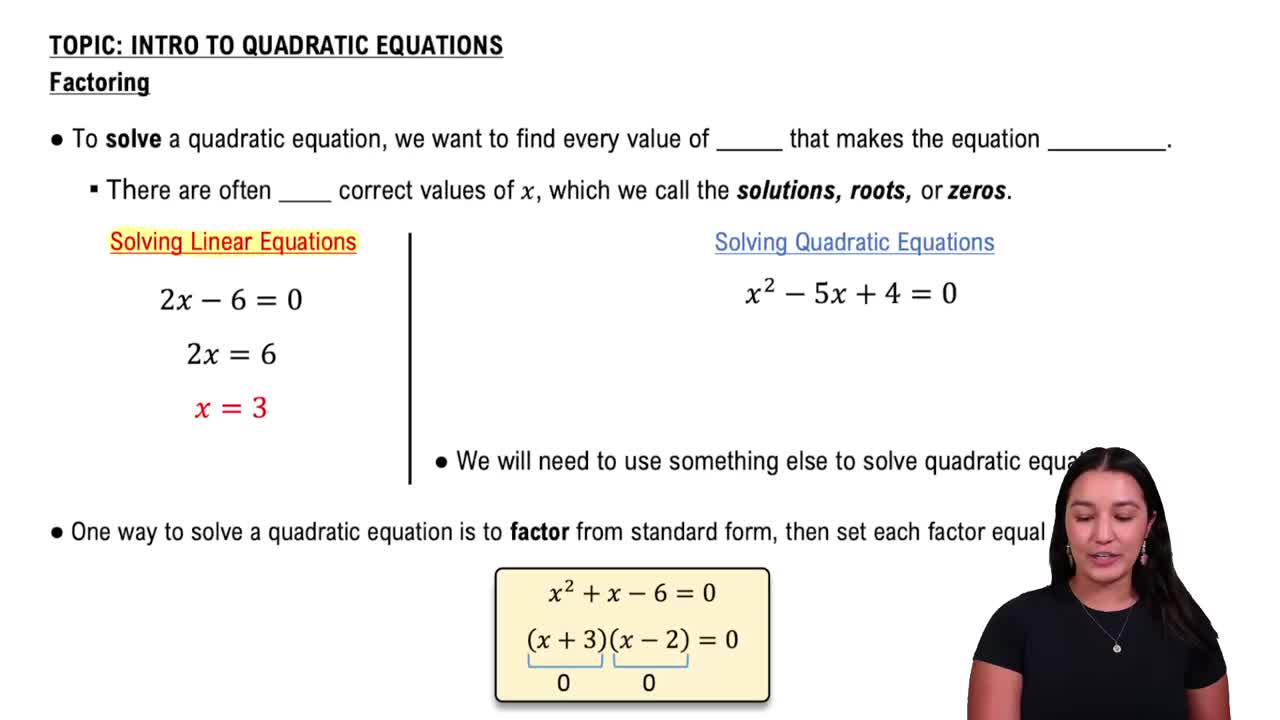Table of contents
- 0. Review of Algebra4h 16m
- 1. Equations & Inequalities3h 18m
- 2. Graphs of Equations43m
- 3. Functions2h 17m
- 4. Polynomial Functions1h 44m
- 5. Rational Functions1h 23m
- 6. Exponential & Logarithmic Functions2h 28m
- 7. Systems of Equations & Matrices4h 6m
- 8. Conic Sections2h 23m
- 9. Sequences, Series, & Induction1h 19m
- 10. Combinatorics & Probability1h 45m
1. Equations & Inequalities
Intro to Quadratic Equations
Problem 77a
Textbook Question
Solve each equation in Exercises 73–81 by the method of your choice. (x-3)^2 - 25 = 0
 Verified step by step guidance
Verified step by step guidance1
Recognize that the equation \((x-3)^2 - 25 = 0\) is a difference of squares.
Rewrite the equation as \((x-3)^2 = 25\).
Take the square root of both sides to solve for \(x-3\), giving \(x-3 = \pm 5\).
Solve the two resulting equations: \(x-3 = 5\) and \(x-3 = -5\).
Add 3 to both sides of each equation to find the values of \(x\).
Recommended similar problem, with video answer:
 Verified Solution
Verified SolutionThis video solution was recommended by our tutors as helpful for the problem above
Video duration:
2mPlay a video:
Was this helpful?
Key Concepts
Here are the essential concepts you must grasp in order to answer the question correctly.
Quadratic Equations
A quadratic equation is a polynomial equation of the form ax^2 + bx + c = 0, where a, b, and c are constants and a ≠ 0. These equations can be solved using various methods, including factoring, completing the square, or applying the quadratic formula. Understanding the structure of quadratic equations is essential for solving them effectively.
Recommended video:

Introduction to Quadratic Equations
Factoring
Factoring involves expressing a polynomial as a product of its factors. For quadratic equations, this often means rewriting the equation in a form that allows for easy identification of roots. In the given equation, (x-3)^2 - 25 can be recognized as a difference of squares, which can be factored into (x-3-5)(x-3+5) = 0, simplifying the solving process.
Recommended video:
Guided course

Factor by Grouping
Difference of Squares
The difference of squares is a specific algebraic identity that states a^2 - b^2 = (a - b)(a + b). This concept is crucial when dealing with equations that can be expressed in this form, as it allows for straightforward factoring. In the context of the given equation, recognizing (x-3)^2 - 25 as a difference of squares facilitates finding the solutions quickly.
Recommended video:

Solving Quadratic Equations by Completing the Square

 5:35m
5:35mWatch next
Master Introduction to Quadratic Equations with a bite sized video explanation from Callie
Start learningRelated Videos
Related Practice










